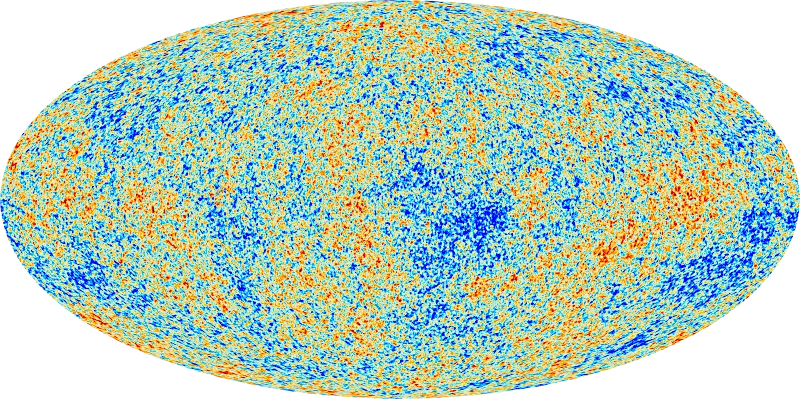or
Why there are no Parallel Universes
The Multiverse has become a hotly discussed theory in physics in recent decades. I won’t get into the details of that, in part because I am not qualified to do so, but it all has to do with the mathematics of the Big Bang and the Initial Singularity. In a nutshell The Multiverse is a consequence of an infinite number of ongoing Big Bang events.
The Smoking Gun for “The Butterfly Effect”
Physicists have speculated that if there are an infinite number of universes, all governed by the same physical and mathematical laws, there must also be an infinite number of parallel universes. In these parallel unverses alternate versions of ourselves live identical, and nearly identical lives. This humble, mostly ignorant, layman, begs to differ. It all has to do with the picture of the cosmic microwave background radiation, CMBR, from the Big Bang taken by the Planck satellite in 2013.

When that cosmic microwave background radiation was first viewed it looked uniform and featureless. But with the highly sensitive instruments of the Planck Satellite the image was enhanced and it turned out that there were subtle temperature variations.
According to our current understanding of physics we have Einstein’s world of universal physics and the quantum world of subatomic physics. Universal physics, the physics that allows us to understand the movement of very big bodies, such as planets, stars and galaxies, are understood and calculated using Einstein’s laws of relativity. The mathematics of quantum mechanics is how we understand and interact with the mechanics of the extremely small, subatomic particles. At this time physicists have been unable to reconcile those two sets of equations.
However, there was a time when this was not the case. When you look at that famous picture of the CMBR the subtle differences in temperature are a product of the randomness of quantum mechanics, and they are what lead to the structure we see in our universe, and this proves that the “butterfly effect” is real. The “butterfly effect” is the idea that seemingly insignificant actions, such as random quantum fluctuations, can have enormous consequences. This was most famously expressed in the short story “A Sound of Thunder” by Ray Bradbury, first published in 1952.
The Infinitely Random Nature of Quantum Mechanics
The thing is that the motions of subatomic particles, as expressed in the theories of quantum mechanics, are all random. And they aren’t just random, they are infinitely random. Their movements are expressed as probabilities, but there is no subatomic grid for them to snap to, like pixels on a monitor. So while the motions of subatomic particles can be reliably predicted to fall within a certain range a certain percentage of the time, their actual positions in spacetime are infinitely random, and the more precise your measuring tools are, the more this becomes apparent.
The only conclusion you can draw from this is that parallel universes are simply not a mathematical possibility. You have an almost impossible to quantify number of subatomic particles, each with an infinite number of potential positions, even if the multiverse is infinite, and even if those random quantum fluctuations only determine the structure of the given universe, there will be no parallel universes, it simply isn’t mathematically possible. Every universe is distinct, and unique.
Certainly there will be an infinite number of universes with similar characteristics, and similar structures, but none of them will be identical, or even close to being identical. The other interesting logical conclusions that can be drawn from are, that no matter how much you know, there is always more to learn, and no matter what happens, the multiverse will never reach the end of probabilities or possibilities.
There will always be surprises in an infinite multiverse.

I find one small potential flaw in the argument, but I don’t have the science to discern if it’s actually a flaw:
If there are an infinite number of universes, there would be universes that were infinitely close in scope to ours– one molecule off in one corner of one spec of the universe? if that’s a misstatement with respect to understanding the meaning of infinite in this context, that’s my lack of a math/physics background (no physics, minimal math studies).
the larger question for me is whether or not the energy required to perceive let alone interact with those infinite universes would not be greater than the sum energy present in our own universe. my gut says leaving our universe to visit another would take more energy than is present in our universe, but no science to back that up either….
My guess is that there are no universes that are even remotely identical. They are all unique.
Travelling between universes is another question entirely. I’ll do a post on levels of journey sometime.
I will leave you with this thought though. Scientists are now fairly certain that even the earliest stars that formed approximately 100 million years after the Big Bang had planets around them. Now they were not likely capable of supporting life was we know it, but it would be reasonable to assume that within 6 billion years of the Big Bang there was intelligent, advanced tool using life present in the universe.
If you accept that Planet Earth is being visited by intelligent life from other solar systems, which I do, I think the evidence in support of that assertion is overwhelming, then there is a chance that some of that life could be as much as 7 billion years, or more, more technologically advanced than we humans are. When you see how humans have advanced technologically in just the past 200 years, that leaves a lot of room for imagination.
I think it’s safe to say that if it is at all possible to travel between universes in an infinite multiverse, it has been done. But it’s beyond our current understanding of physics to even imagine how that could be done, at least as far as I know. Spacetime ends at the edges of the universe, as far as we understand, and I for one can’t imagine what it would take to journey outside of spacetime, other than to say that perhaps that is what happens when life ends.